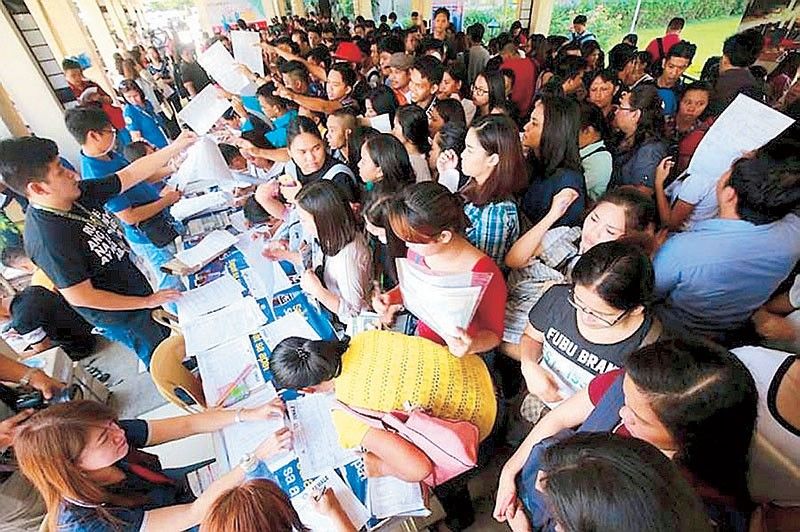Jobless rate declines to 3.2% in November

MANILA, Philippines — The country saw a drop in unemployment in November as more people secured jobs due to greater labor demand by certain sectors during the holiday season, according to the Philippine Statistics Authority (PSA).
In a press conference, National Statistician Dennis Mapa said based on the latest Labor Force Survey conducted by the PSA, the unemployment rate declined to 3.2 percent in November 2024 from 3.9 percent in October of the same year and 3.6 percent in November 2023.
This translates to 1.66 million jobless Filipinos in November 2024, down from the previous month’s 1.97 million and 1.83 million in November 2023.
The employment rate, on the other hand, rose to 96.8 percent in November last year from 96.1 percent in October 2024 and 96.4 percent in November 2023.
This is equivalent to 49.54 million employed Filipinos in November 2024, higher than the 48.16 million in October last year, but down from 49.64 million in November 2023.
Mapa cited the seasonal increase in demand for labor during the holiday season in the last quarter of the year as the reason for the latest improvement in employment and unemployment data.
“Usually in the last quarter, those three months, we see an increase in accommodation services, restaurants and of course, key inputs of these like food products,” he said.
On a year-on-year comparison, industries with the largest increase in employment in November last year are manufacturing (784,000); accommodation and food service activities (528,000); human health and social work activities (303,000); other service activities (239,000), and transportation and storage (190,000).
Posting the biggest year-on-year decline in employment in November last year are agriculture and forestry (-1.99 million); wholesale and retail trade, repair of motor vehicles and motorcycles (-327,000), and fishing and aquaculture (-276,000).
PSA data also showed that underemployment in the country slid to 10.8 percent in November 2024 from 12.6 percent in October last year and 11.7 percent in November 2023, indicating improvements in the quality of jobs.
There were 5.35 million underemployed Filipinos or those looking for additional hours of work or job in November 2024, lower than the 6.08 million in October last year and 5.79 million in November 2023.
The country’s labor force participation rate (LFPR) climbed to 64.6 percent in November 2024 from 63.3 percent in October last year, but dipped from 65.9 percent in November 2023.
An estimated 51.20 million Filipinos were in the labor force in November last year, higher than the 50.12 million in October 2024, but down from 51.47 million in November 2023.
Youth LFPR decreased to 32.4 percent in November last year from 34.4 percent in the same month in 2023, with many young people citing schooling (402,000) for not participating in the workforce.
Female participation in the labor force also fell to 53.9 percent in November 2024 from 55.4 percent in the same month in 2023 primarily due to prime-working-age women prioritizing household responsibilities (445,000).
While the Philippine labor market continues to strengthen, the National Economic and Development Authority (NEDA) said the government would continue to prioritize improvements in job quality and income.
“Our labor market remains robust, with consistently high employment rates and reduced underemployment. The next step is to expand business and employment opportunities to enable more Filipinos to actively and productively contribute to the economy,” NEDA Secretary Arsenio Balisacan said.
He said the government would also encourage businesses to implement skills training programs to ensure competitive wages for workers as they raise their productivity.
“The government needs to facilitate the adoption of alternative work arrangements to account for workers’ evolving preferences while considering organizations’ emerging demands. In addition, the government focuses on accelerating government programs that will increase employability, especially among the youth,” Balisacan said.
He also emphasized that the timely implementation of the CREATE MORE Act and the Enterprise-Based Education and Training Framework Act are seen to help attract investments, create jobs, as well as enhance the skills of the workforce to meet emerging industries’ demands.
Other measures being undertaken include the expansion of the Department of Social Welfare and Development’s cash-for-work and training programs to reach climate-vulnerable communities, as well as the development of a tool for improved assessment of beneficiaries’ eligibility for aid to minimize leakage or duplication.
“In line with these efforts, we remain committed to achieving our employment targets under the Philippine Development Plan 2023-2028. The 2024 Philippine Development Report, which NEDA will release this month, will guide our efforts with evidence-based strategies to create quality jobs and sustain economic growth,” Balisacan said.
- Latest
- Trending

































